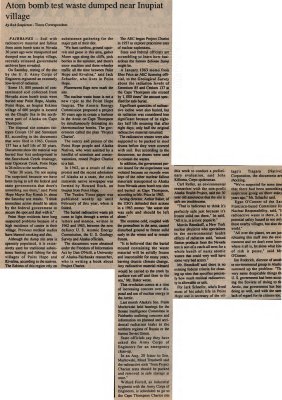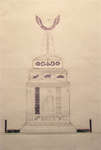"Atom bomb test waste dumped near Inupiat village"
- Publication
- Tekawennake News (Ohsweken, Ontario), 14 Oct 1992
- Full Text
- Atom bomb test waste dumped near Inupiat villageby Rob Stapleton - Times Correspondent
FAIRBANKS -- Soil with radioactive material and fallout from atom bomb tests in Nevada 30 years ago were transported and dumped near an Inupiat village, recently released government archives have revealed. On Saturday, testing of the site by the U.S. Army Corps of Engineers registered an extremely low-level of radiation.
Some 15,000 pounds or contaminated soil collected from Nevada atom bomb tests were buried near Point Hope, Alaska.
Point Hope, an Inupiat Eskimo village or 680 people is located on the Chughi Sea in the northwest part of Alaska on Cape Thompson.
The disposal site contains isotopes Cesium 137 and Strontium 85, according to the documents that were filed in 1963. Cesium 137 has a half life of 30 years. Documents show the material was buried four feet underground in the Snowbank Creek drainage, near Ogotoruk Creek. Point Hope is 26 miles to the northwest.
"After 30 years, I'm not saying I'm surprised because we have been trying tell the federal and state governments that there's something out there," said Point Hope Mayor Ray Konuk Jr. about the Saturday test results. "I think immediate action should be taken by the federal government to secure the spot and deal with it."
Point Hope residents have long suspected problems because of a high incidence of cancer in their village. Previous medical studies have blamed smoking and diet.
Although the dump site area is sparsely populated, it is extensively used for traditional subsistence hunting and fishing for the villages of Point Hope and Kivalina, according to the natives. The Eskimo of this region rely on subsistence gathering for the major part of their diet.
"We hunt caribou, ground squirrels and geese in this area, gather Murre eggs along the cliffs, pick berries in the summer, and there's snow machine and three-wheeler traffic all the time between Point Hope and Kivalina," said Jack Schaefer, who lives in Point Hope.
Fluorescent flags now mark the site.
The nuclear waste issue is not a new topic to the Point Hope Inupiat. The Atomic Energy Commission proposed a project 30 years ago to create a harbour in the Arctic on Cape Thompson by simultaneously detonating six thermonuclear bombs. The government called the plan "Project Chariot."
The outcry and protest of the Point Hope people and Alaska Natives, who were assisted by a handful of scientists and conservationists, reined Project Chariot to a halt.
In 1962, as a result of this protest and the recent admission of Alaska as a state, the only statewide native newspaper was formed by Howard Rock, an Inupiat from Point Hope.
The Tundra Times paper was published weekly up until February of this year, when it folded. The buried radioactive waste pit came to light through a series of letters and memos, written in 1962 and 1963, between the now defunct U.S. Atomic Energy Commission, the U.S. Geology Survey and Alaska officials.
The documents were obtained under the Freedom of Information Act by Dan O'Neill, a University of Alaska-Fairbanks researcher, who is writing a book about Project Chariot.
The AEC began Project Chariot in 1957 to explore peacetime uses of nuclear explosions.
State and federal officials are scrambling to learn how hazardous the former defense dump might be.
A January 1963 memo from Eber Price an AEC licensing official, to the Geological Survey about the radiation levels of Strontium 85 and Cesium 137 at the Cape Thompson site exceed by 1,000 times the amount specified for safe burial.
Significant quantities of radioactive iodine were also buried, but its radiation was considered less significant because of its eight day half life meaning that after eight days, only half the original radioactive material remained.
The radioactive wastes were also supposed to be packed in steel drums before they were covered with soil. But according to the documents, no drums were used to contain the wastes.
In addition, the government permit issued for the experiment was violated because no records were kept of the other nuclear fallout materials transported to Alaska from Nevada atom bomb test sites and buried at Cape Thompson, according to Mr. Price in 1963.
Acting director, Arthur Baker, of the USG's defended their actions in a 1963 memo: "the waste site was safe and should be left alone."
The extreme cold, coupled with the permafrost in the area, caused disturbed ground to freeze solid early in the winter and to remain frozen.
"It is believed that the burial mound containing the waste material will be solidly frozen and inaccessible for many years, barring drastic climate change. Any radioactive material released would be carried to the creek by surface run-off and then to the sea," Mr. Baker wrote.
This revelation comes at a time of increasing concern over disposal and use of nuclear energy in the Arctic.
Last month Alaska's Sen. Frank Murkowski held hearings for the Senate Intelligence Committee in Fairbanks outlining concerns and information on planned and accidental radiation leaks in the northern regions of Russia or the former Soviet Union.
State officials say they have asked the Army Corps of Engineers for an emergency clean-up. In an Aug. 28 letter to Sen. Murkowski, Mead Treadwell said the radioactive soils "from Project Chariot tests should be packed and removed to safe storage at once."
Willard Ferrell, an industrial hygienist with the Army Corps of Engineers, is scheduled to go to the Cape Thompson Chariot site this week to conduct a preliminary evaluation, said John Killorna, Corps spokesman.
Carl Reller, an environmental researcher with the non-profit Alaska Health Project, said the 30 year old assurances that the site is safe are troublesome.
"That is ludicrous to think it's perfectly safe just because it's frozen solid out there," he said. "All it is, is a toxic popsicle."
Marvin Resnikoff, a New York nuclear physicist who specializes in the environmental health effects of radiation said, "mixed fission products from the Nevada test is sort of a catch-all term for a whole bunch of nasty atomic wastes that could very well have some very bad actors."
Mr. Resnikoff said there is no existing federal criteria for cleaning up sites that specifies precisely how much residual radioactivity is allowable or safe.
For Jack Schaefer, who's lived most of his adult life in Point Hope and is secretary of the village's Tiagara (Native) Corporation, the documents are shocking.
"We've suspected for some time there had been something suspicious going on there many years ago," Mr. Schaefer said.
Egan O'Conner of the San Francisco-based Committee for Nuclear Responsibility, said, "if radioactive waste is there, it is a potential safety hazard to not only those nearby villages, but also the world."
"All over the planet, we are just releasing this stuff into the environment and we don't know where it all is, let alone what kind of risk it poses," said Mr. O'Conner.
Jim Roderick, director of another environmental group in Alaska summed up the problem: "The very same despicable things the U.S. government had been accusing the Soviets of doing to the Arctic, our government has been doing as well, and with the same lack of regard for its citizens too.
- Creator
- Stapleton, Rob, Author
- Media Type
- Text
- Newspaper
- Item Type
- Clippings
- Publisher
- Tekawennake News
- Place of Publication
- Six Nations of the Grand River, ON
- Date of Publication
- 14 Oct 1992
- Subject(s)
- Personal Name(s)
- Konuk Jr., Ray ; Schaefer, Jack ; Baker, Arthur ; Rock, Howard ; O'Neill, Dan ; Murkowski, Frank ; Treadwell, Mead ; Ferrell, Willard ; Killorna, John ; Reller, Carl ; Resnikoff, Marvin ; O'Conner ; Egan ; Roderick, Jim.
- Corporate Name(s)
- U.S. Army Corps of Engineers ; Government of the United States.
- Local identifier
- SNPL005066v00d
- Language of Item
- English
- Geographic Coverage
-
-
Alaska, United States
Latitude: 64.83502 Longitude: -147.65307
-
- Creative Commons licence
 [more details]
[more details]- Copyright Statement
- Public domain: Copyright has expired according to Canadian law. No restrictions on use.
- Copyright Date
- 1992
- Copyright Holder
- Tekawennake News
- Contact
- Six Nations Public LibraryEmail:info@snpl.ca
Website:
Agency street/mail address:1679 Chiefswood Rd
PO Box 149
Ohsweken, ON N0A 1M0
519-445-2954




